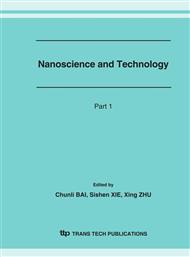p.1
p.5
p.9
p.13
p.17
p.21
p.25
Synthesis of Disarrayed and Arrayed ZnO Nanowires by Physical Evaporation Deposition Approach without Catalysts
Abstract:
Large-scaled ZnO nanowires have been successfully synthesized by heating and evaporating zinc powders directly without the assistance of any catalysts or additives. We acquired disarrayed and arrayed ZnO nanowires respectively on Si(100) substrates and c-oriented ZnO thin film. The disarrayed ZnO nanowires are about 40nm in diameter and 10μm in length, evenly and randomly distributed on the substrate; while the arrayed nanowires are about 60nm in diameter and 3-4μm in length, well aligned along the normal direction of the substrate. XRD and TEM results reveal that in both kinds of the products, most of the synthesized ZnO nanowires are single crystalline in a hexagonal structure and grow along the [001] direction. During the growth process of arrayed ZnO nanowires, the c-oriented ZnO thin film control the growth direction. Photoluminescence spectrums were measured showing that both of the disarrayed and arrayed ZnO nanowires have a strong ultraviolet emission around 380nm. Such results suggest the synthesized ZnO nanowires, especially arrayed nanowires can be applied to excellent optoelectronic devices.
Info:
Periodical:
Pages:
9-12
Citation:
Online since:
March 2007
Authors:
Keywords:
Price:
Сopyright:
© 2007 Trans Tech Publications Ltd. All Rights Reserved
Share:
Citation:


